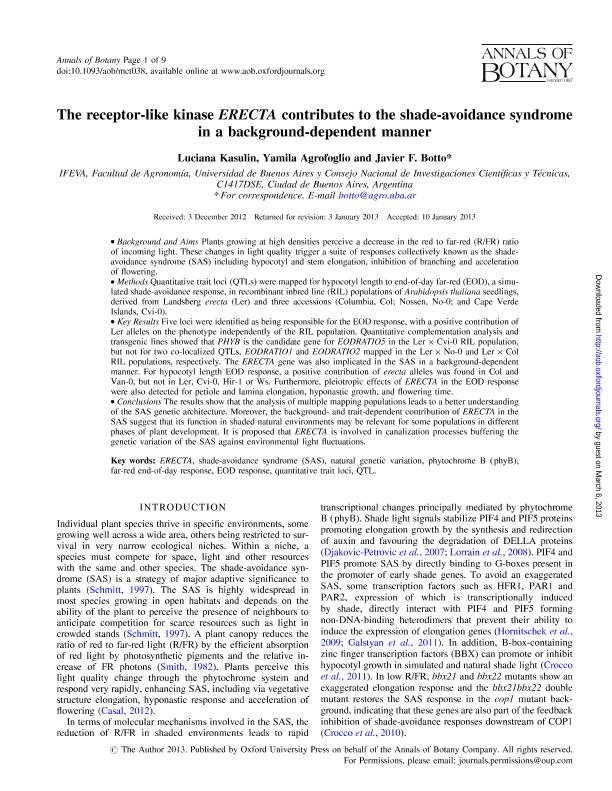Artículo
The receptor-like kinase ERECTA contributes to the shade-avoidance syndrome in a background-dependent manner
Fecha de publicación:
02/2013
Editorial:
Oxford University Press
Revista:
Annals of Botany
ISSN:
0305-7364
Idioma:
Inglés
Tipo de recurso:
Artículo publicado
Clasificación temática:
Resumen
Background and Aims Plants growing at high densities perceive a decrease in the red to far-red (R/FR) ratio of incoming light. These changes in light quality trigger a suite of responses collectively known as the shade-avoidance syndrome (SAS) including hypocotyl and stem elongation, inhibition of branching and acceleration of flowering.
Methods Quantitative trait loci (QTLs) were mapped for hypocotyl length to end-of-day far-red (EOD), a simulated shade-avoidance response, in recombinant inbred line (RIL) populations of Arabidopsis thaliana seedlings, derived from Landsberg erecta (Ler) and three accessions (Columbia, Col; Nossen, No-0; and Cape Verde Islands, Cvi-0).
Key Results Five loci were identified as being responsible for the EOD response, with a positive contribution of Ler alleles on the phenotype independently of the RIL population. Quantitative complementation analysis and transgenic lines showed that PHYB is the candidate gene for EODRATIO5 in the Ler × Cvi-0 RIL population, but not for two co-localized QTLs, EODRATIO1 and EODRATIO2 mapped in the Ler × No-0 and Ler × Col RIL populations, respectively. The ERECTA gene was also implicated in the SAS in a background-dependent manner. For hypocotyl length EOD response, a positive contribution of erecta alleles was found in Col and Van-0, but not in Ler, Cvi-0, Hir-1 or Ws. Furthermore, pleiotropic effects of ERECTA in the EOD response were also detected for petiole and lamina elongation, hyponastic growth, and flowering time.
Conclusions The results show that the analysis of multiple mapping populations leads to a better understanding of the SAS genetic architecture. Moreover, the background- and trait-dependent contribution of ERECTA in the SAS suggest that its function in shaded natural environments may be relevant for some populations in different phases of plant development. It is proposed that ERECTA is involved in canalization processes buffering the genetic variation of the SAS against environmental light fluctuations.
Archivos asociados
Licencia
Identificadores
Colecciones
Articulos(IFEVA)
Articulos de INST.D/INV.FISIOLOGICAS Y ECO.VINCULADAS A L/AGRIC
Articulos de INST.D/INV.FISIOLOGICAS Y ECO.VINCULADAS A L/AGRIC
Citación
Kasulin, Luciana; Agrofoglio, Yamila Carla; Botto, Javier Francisco; The receptor-like kinase ERECTA contributes to the shade-avoidance syndrome in a background-dependent manner; Oxford University Press; Annals of Botany; 111; 2-2013; 811-819
Compartir
Altmétricas




